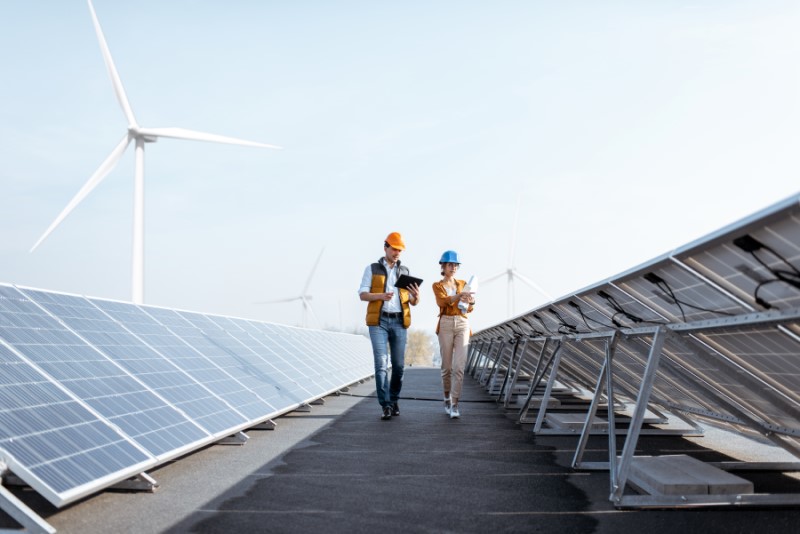
Microsoft at World Mining Congress 2023: Accelerate innovation in mining with AI
Humanity faces an urgent challenge to achieve a sustainable world now and for generations to come. Economic and population growth are expected to increase global energy consumption 50 percent by 2050. If CO2 emissions continue increasing at the current rate, it will more than double the amount present in the atmosphere compared with the pre-industrial era. Global initiatives like the Paris Agreement seek to reduce greenhouse gas emissions and implement strategies to build climate change resilience, but more action is needed. Studies show that we must rapidly reduce CO2 emissions to mitigate the impact of global warming and potential for catastrophic weather events. The urgency is spurring the transition to greener energy, and the consumption of renewable sources such as wind and solar is expected to outpace consumption of nonrenewable sources like petroleum.1
The renewable energy sector relies on critical minerals including graphite, copper, lithium, nickel, and cobalt for batteries and other clean energy technologies. The mining industry plays an essential role in not only fueling and supplying the energy transition, but also in attaining sustainability goals.

Microsoft for Energy and Resources
Transform the energy and resources industry and achieve net zero with technology innovation.
Join Microsoft at the World Mining Congress 2023
Leading mining companies are accelerating the transition to clean energy with digital innovation and implementing ground-breaking solutions with Microsoft technologies that include process automation, cloud migration, predictive analytics, AI, and the Internet of Things (IoT).
I’m looking forward to sharing how companies can leverage AI in the digital sustainable mine of the future at the upcoming World Mining Congress 2023 in Brisbane, Australia. This workshop aims to broaden the discussion beyond technology infrastructure and AI-enabled solutions. For example, a more holistic perspective of AI infrastructure could address the dual challenges of meeting energy demands profitably and efficiently while also driving toward a sustainable future.
First, let’s examine how organizations in the mining industry are stepping up to those challenges.
Transformative solutions for complex challenges
To operate more efficiently and sustainably amid global supply chain disruptions in recent years, mining companies need to decarbonize and bring agility to mission-critical processes like supply chain management. Digital solutions that leverage machine learning and predictive analytics enable faster responses to rapidly changing market conditions and risks that include cybersecurity, geopolitical, and climate events.
The global mining industry is transforming with Microsoft technologies. Sweden’s Sandvik Group, a leader in mining and engineering, wanted to help the mining industry become more sustainable through the adoption of cutting-edge technology. To enable digital transformation, Sandvik developed a remote monitoring solution that provides AI, IoT, and predictive analytics powered by Microsoft Azure Cognitive Services, Azure Databricks, Azure IoT Hub, Azure Machine Learning, and Azure Synapse Analytics. The solution collects and analyzes data from hundreds of sensors, provides actionable insights into equipment performance and status, and helps Sandvik improve predictive maintenance on machines. As a result, its customers can benefit from improved productivity, safety, and energy and fuel efficiency.
Metinvest Holdings in Ukraine is also using Microsoft technology to make significant operational improvements. To increase energy efficiency, Metinvest implemented an AI solution with Azure Data Factory, Azure Machine Learning, and Power BI that was able to predict and control the silicon content of iron to reduce fuel consumption in blast furnaces. The project began by improving fuel-efficiency in blast-furnaces, with plans to embed digital solutions throughout the firm’s value chain.
Building a digital sustainable mine of the future
These customer stories touch on common themes that organizations face on their net-zero journeys. Building the mine of the future requires more than digitizing established processes, as I explained in this recent white paper, “Empowering the Mining Industry.” The complexity of optimizing across interdependent mining and sustainability priorities requires more than standalone applications. We can no longer rely on pencil and paper, simple spreadsheets, or even a collection of industry-specific applications. Optimizing the mine of the future will require each mine to operate as an Intelligence Driven Organization (IDO) with a system of intelligence layer that spans not only the enterprise but interconnects with the greater extended enterprise and ecosystem of partners, suppliers, and customers.
AI and the IDO model are important tools for overcoming the daunting challenge of meeting sustainability regulations and stakeholder requirements while delivering climate-smart minerals faster and more cost-effectively.
Collaborating toward a holistic AI infrastructure
Using AI-based solutions and the IDO model to form the digital sustainable mine of the future will empower miners to quickly respond to rapidly changing conditions. These innovations in operational and energy efficiency are a tremendous step forward. But we can’t stop there. We also need to have broader, more holistic discussions around AI infrastructure. The transition to a cleaner, sustainable future requires our collective efforts to accelerate climate goals while supporting business goals for mining.
To help move toward a shared definition, Microsoft offers a point of view for the digital sustainable mine of the future, which includes not only the technology foundation but also an integrated model that addresses both business and sustainability needs.
The digital sustainable mine of the future isn’t built on technology alone. It relies on scaffolding that includes aligned policy makers, the facilitation of ongoing research, and stakeholders that provide insights that build understanding, inform decisions, and drive effective actions. The infrastructure for AI must also inform focused investment to achieve mission, government, community, and business goals. There must be a regulatory environment in place for the effective and ethical use of AI. Trust must be earned and maintained through verification, validation, traceability, auditability, and accountability. And finally, an infrastructure for AI must effectively leverage current technology while rapidly adapting to accelerating innovation.
Capabilities and principles for intelligence-driven ecosystems
Operating with a shared framework of capabilities and principles, the infrastructure for AI combines with intelligence-driven organizations to form intelligence driven-ecosystems. Systems of intelligence improve business operations and sustainability in a continuous feedback loop that in turn informs the decisions of policy makers, researchers, stakeholders, investors, and regulators.
This larger and more encompassing vision of the infrastructure for AI enables us to accelerate toward climate goals while also attaining desirable business outcomes for miners. Combining sustainability goals with business outcome is important for mining organizations, who must operate productively and profitably while investing in climate positive projects.
We all share the environmental outcome of our planet. By working together within an intelligence-driven ecosystem, we can move forward toward a sustainable energy future.
Additional resources
- Learn more about how Microsoft works to enable the sustainable growth of renewables in the mining industry.
- 3 key takeaways from CERAWeek 2022 and a cleaner future for the energy transition.
- Learn more about themes and actions critical for energy transition.
- Read more about how Microsoft partners with energy companies to accelerate digital transformation.
- Microsoft brings mixed reality and new immersive collaboration tools to industrial metaverse customers.
- Enable your data to do more in the cloud with our energy data manager.
- To learn how to attract, train, and retain employees for your next-generation workforce, visit our transform your workforce employee retention website.
- To learn more about Microsoft for Energy and Resources, visit our future of energy industry solutions website.




